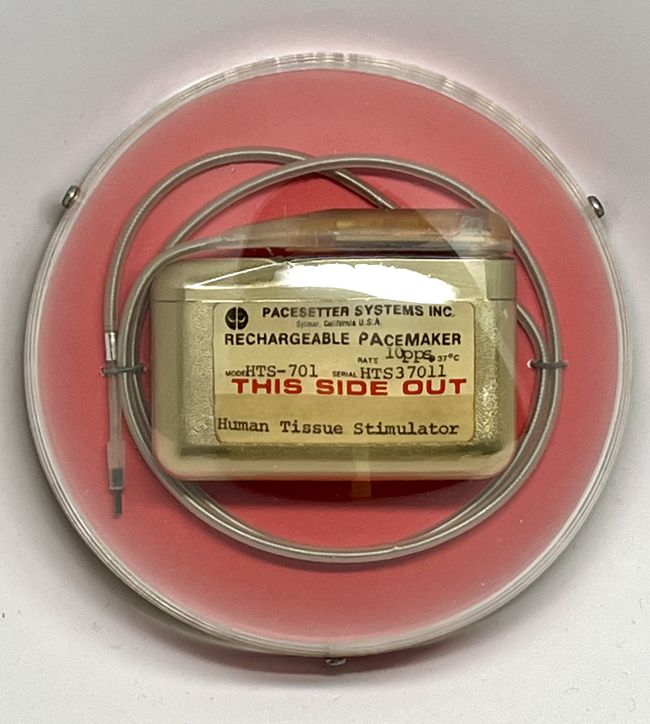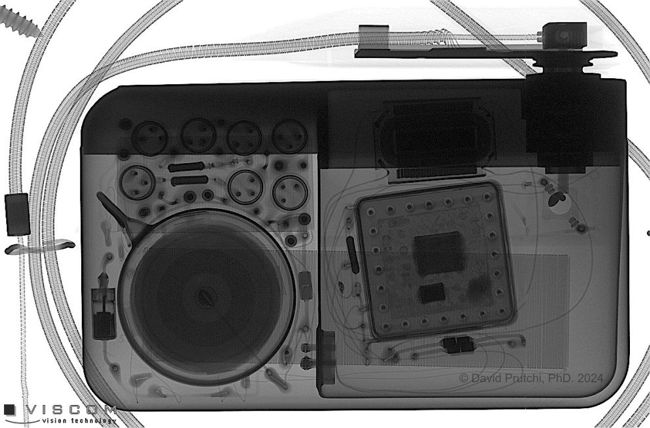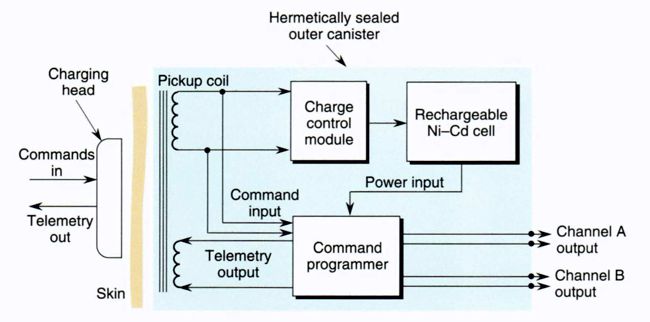
Pacesetter Human Tissue Stimulator (HTS) (c) David Prutchi, Ph.D., 2024
I recently acquired this device on eBay® (from a very kind seller, I may add). Although labeled as a “Rechargeable Pacemaker,” and looks just like the one at the Udvar-Hazy about which I had posted a few years ago, it is in fact a neurostimulator.
The Human Tissue Stimulator or “HTS” was developed subsequently to the rechargeable pacemaker, prompted by the clinical need for a rechargeable implantable neurostimulator.
Robert Fischel described the development of this device for the Johns Hopkins APL Technical Digest in 1992:
“At the time the rechargeable pacemaker was in regular human use, Dr. Irving S. Cooper in New York City published an article on electrical stimulation to treat epilepsy.
Electrical stimulation was also being used to treat such diverse human disorders as cerebral palsy, multiple sclerosis, and intractable pain. All these applications required much higher levels of electrical power than did a cardiac pacemaker. It was logical then to build a bigger Ni-Cd cell (to be exact, 1.0 A·h) and apply it to create a rechargeable Human Tissue Stimulator (HTS) for a variety of applications.
Because this was another application of space technology, a proposal was submitted to the NASA group responsible for the transfer of space technology into the public domain. With the support of Donald Friedman, who headed the development of such programs at the Goddard Space Flight Center, APL received funding to develop the HTS device.
…
On 7 March 1981, the first HTS was implanted at The Johns Hopkins Hospital in a 34-year-old Baltimore man who had nerve damage and chronic pain as a result of a severe wrist injury. By stimulating nerves in the neck that connect the wrist to the brain, the HTS successfully eliminated that pain, which was not treatable by any other therapy.”
The 1Ah NiCd cell of the HTS was recharged by rectifying the 25kHz transcutaneous recharge signal received by an elongated pickup coil. In addition, a computer-controlled programmer could communicate with the HTS to change 9 of its operating parameters.

Radiograph of Human Tissue Stimulator (c) David Prutchi, Ph.D., 2024
Back to the unit I purchased from eBay® – It was advertised as a paperweight, so I was expecting it to be a demo can filled with lead weights. However, I was very surprised to see electronics inside it when my colleagues and I inspected it in the office’s industrial x-ray cabinet (thank you Cami!). The radiograph clearly shows the recharge pickup coil (long rectangle on bottom showing wire windings), the NiCd cell (circular element at left), and what seems to be a separate enclosure (right hand side) containing the stimulation ASIC and maybe an output transformer (top right side, left of the feedthrough).
The construction of the stimulation circuit is a bit strange – it looks like the ASIC is dead-bugged and wired to the other components rather than part of a circuit board. The angle of the ASIC is also very odd, making me think this might have been a handmade prototype.
Next step – see if it outputs anything to the lead by exposing it to a 25kHz charging field…

Block diagram of a two-channel HTS. From: R. E. Fischell, “The Development of Implantable Medical Devices at the Applied Physics Laboratory”, Johns Hopkins APL Technical Digest, Volume 13, Number J (1992)

Dr. Donlin M. Long (right) adjusting the electrical stimulation parameters for the first Human Tissue Stimulator patient. From: R. E. Fischell, “The Development of Implantable Medical Devices at the Applied Physics Laboratory”, Johns Hopkins APL Technical Digest, Volume 13, Number J (1992)
